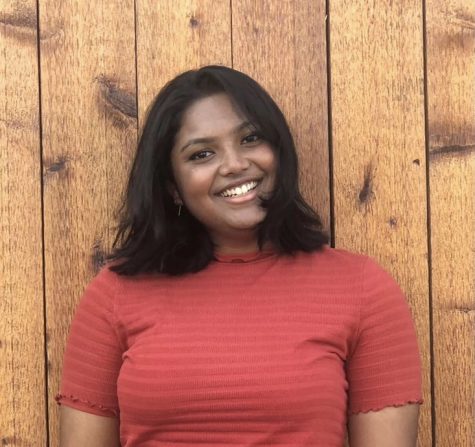The Hidden Dream: Breaking Down Barriers For Immigrants
Liberty activist co-founds organization to address the challenges visa-dependent children face
Photo by: 1326, Edited by: Mollie Banstetter
Sarvani Kunapareddy (12) is one of the millions of immigrants in America who are affected by the green card backlog.
America is Sarvani Kunapareddy’s home. For the majority of her life, Kunapareddy has known St. Louis suburbs, playing with friends underneath the American flag, pledging allegiance before class each day. However, due to her visa status, her future as an American is uncertain.
Kunapareddy, a senior, is one of four million immigrants left behind by the visa backlog. America’s complex and outdated immigration system makes it extremely difficult for visa carriers to obtain a green card, granting them permanent legal residence, a required step for becoming a citizen. Quotas and caps can leave them waiting in line indefinitely. For some it takes decades; others won’t even have the opportunity to become a citizen until after they die.
This harsh reality flipped Kunapareddy’s world upside down.
“It was painful to learn that I wasn’t really at home here,” Kunapareddy said. “It took me a while to get used to it. I blamed myself, even though I didn’t have control.”
Gazing at her future, now blocked by seemingly impassable barriers, Kunapareddy knew that she couldn’t just sit back. And so she fought— not just to change her own life, but for the lives of others.
“This couldn’t be the end,” Kunapareddy said.
Earlier this year, one student-written article on Kunapareddy’s activism was named a Best of SNO Story of the Year; another featured on Ms. Magazine– quickly gaining traction on social media. As her story was shared, Kunapareddy connected with other young immigrants with similar experiences. Deciding they needed to do more, she and five other students co-founded The Hidden Dream organization.

The Hidden Dream’s mission is to “raise awareness of the countless struggles faced by visa immigrants, share resources, and create a community to uplift.”
One of their largest emphases is on education. Visa dependent children are considered international students when applying to colleges, rendering them ineligible for financial aid and most scholarship opportunities. In addition, once they turn 21 they “age out” of their parents’ visa— meaning they either have to apply for a student visa or self-deport. The process is emotionally and financially taxing.
Kunapareddy realized this when applying for scholarships.
“In March, I applied for a scholarship that said there was no citizenship requirement. I ended up being a finalist and was going to have an interview, but because I was considered an international student, the interview was canceled,” Kunapareddy said.
Financial aid isn’t the only barrier visa dependents face when it comes to education.

Harishree Karthik is a 20-year-old neuroscience student who primarily works on social media for The Hidden Dream. The aging out process has added unnecessary confusion and difficulty to her already strenuous higher education, pushing her to the back of a line she’s been waiting in for 13 years. Instead of being able to pursue her promising career goals when she finishes school, Karthik has to restart the immigration process alone.
“The biggest hit was me aging out. I age out of the system when I turn 21, which means my father cannot include me as a dependent when he files for a green card,” Karthik said. “My parents have sacrificed many things for my chance at a life in America. But it seems like their hard work and resilience has gone to waste because I have to self-deport and restart my own immigration process from the start. I have started that process already by switching to an international student visa. Now I have started my own lifelong immigration process.”
To help fund the high cost of education that immigrant children face, the group created a scholarship fund. Each year, they plan to give two $1000 scholarships to visa dependent high school seniors and undergraduate students. Out of a pool of 35 applicants, they recently selected two inaugural recipients. This is just the start of what The Hidden Dream wants their fund to become.
“I hope we can develop it into something bigger,” Kunapareddy said.
Kunapareddy remembers feeling out of place when she learned of her immigration status, surrounded by people blissfully unaware of what she was going through. In hopes of helping them feel less alone, The Hidden Dream aims to create a community for young immigrants. Via the group’s Slack, an online communication platform. they can find support and connect with each other. In addition, The Hidden Dream holds virtual conferences and workshops to help them navigate college and beyond.
According to Kunapareddy, this community has already made an impact.
“I’ve seen a lot of kids start reaching out and beginning to feel understood,” Kunapareddy said. “They’re happy there are others like them.”
Over the past four months, The Hidden Dream’s Instagram has amassed more than 2,000 followers. Here, they work to educate the general public and share relevant information. Their “Hidden Dreamer” series tells the stories of immigrants in their own words. Though the students’ faces are pictured in black and white, their voices speak out in vibrant color, beautifully painting the hardships most Americans will never have to face.
“The immigration system is very complicated and is not immigrant-friendly. The system has many flaws, which has led to immigrants suffering. America is a nation built on immigrants but has forgotten the importance of immigrants. I wish people understood the importance of immigration. There are many misconceptions like immigrants stealing jobs that cannot be further from reality,” Karthik said. “In reality, immigrants give a lot and suffer a lot to have a chance at the American Dream, which has become unattainable. Immigrants are hard-working families trying to obtain a better quality of living. I wish people viewed immigrants as their hard-working neighbors.”
Kunapareddy shares similar sentiments.
“The American Dream is so well advertised and marketed but falls short. There’s always been something falling out of my reach since high school,” Kunapareddy said. “It kind of fueled me more. I want to bring change about because it’s out of reach for so many people.”
In a country that leaves millions of immigrants behind, the American Dream young kids were once taught is nonexistent. But that doesn’t mean it can’t be redefined. Instead, the “American Dream” lies in the hearts of Hidden Dreamers, resilient and diligent and hopeful, passionate and proud, and bright.
Learn More About the Green Card Backlog:
[foogallery id=”23626″]
Your donation will support the student journalists of Liberty High School. Your contribution will allow us to purchase equipment and cover our annual website hosting costs.



